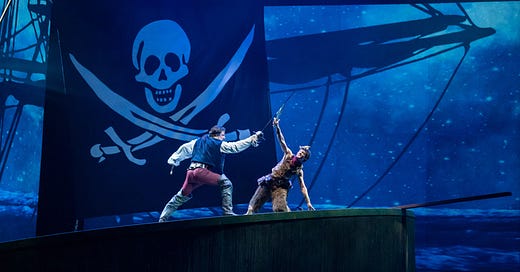Peter Pan, the story of a boy who never grows up, flies to magical lands, and fights pirates, has enchanted audiences worldwide through plays, films, and television for over a century. My first memories of Peter Pan begin with the 2003 film adaptation starring Jeremy Sumpter and Jason Isaacs. I adore James Newton Howard’s score, especially the main theme, “Flying,” which transports the listener throughout Neverland. The song was so popular Disney Parks used it in commercials. Peter Pan is adventurous and thrilling, so who is the man behind the Peter Pan story? J.M. Barrie had an active imagination and was drawn to theatre from a very early age, writing plays and staging them for his friends.1
However, the death of his brother, David, haunted his childhood. Barrie was fixated on his death, even dressing up in his clothes and performing as him before his grieving mother, which cemented for him the idea of being trapped in time, and never growing old. Many years later, Barrie was introduced to and befriended the Llewelyn Davies boys, who Barrie would act out fantastical stories with and later inspire the Peter Pan story. They often played games together, for Barrie taps into his inner child, a quality essential to making great live theatre. Lauren M. Gunderson’s adaptation of Peter Pan and Wendy, currently playing at Kansas City Repertory Theatre, taps into the child-like wonder of the original Peter Pan through its technical elements, but its script struggles to soar.
From the first scene in Gunderson’s retelling of the Peter Pan myth, we witness the clash of upper-middle-class social codes and personal dreams. Wendy Darling (Cereyna Jade Bougouneau) is fascinated by astronomy and aspires to be a scientist like Marie Curie. Although her mother (Kushi Beauchamp, who also plays Tinker Bell) has different plans for her future, pushing her towards finishing school. Mrs. Darling wants Wendy to be a proper young lady, to which her brother John (Sheridan Anthony Mirador) replies, “ She’s not a young lady; she’s a young Wendy.” But any propriety or logic the Darling family believed in is shattered when Peter Pan (Harrison Bryan) flies in through their window. Bryan’s characterization of Peter Pan is a mixture of “fraternity brother” and the energetic Peter Pan we know from the Disney film and Cathy Rigby’s portrayal. Bougouneau’s tough Wendy balances Bryan’s rambunctious Peter incredibly well.
Peter whisks the Darling children to Neverland. The journey to Neverland is a visual feast thanks to Mike Tutaj’s projection design. It is a swirling ride through the cosmos, dazzling at every moment. When the children flew for the first time, I reawakened to the inner child who always dreamt of flying, but ultimately the sequence lost its magic when the children were just hanging in midair. It was a lost opportunity to utilize the excellent shadow ensemble, which would have helped create dynamic staging against the bold visuals in the background. Courtney O’Neill’s scenic design takes us from practical London to Neverland, where nature dominates. The mossy Neverland forest set’s vibrant colors, merged with Tutaj’s projection design, are mystical and exciting. The turntable set works for a story exploring time and its impact on human life. I am obsessed with André Pluess’ sound design. It is epic and dreamy and compliments the different tones within the play.
When the Darlings arrive in Neverland, they meet the Lost Boys (Dri Hernandez, Tanner Rose, and Terrace Wyatt Jr. I saw Gregory Williams go on for Rose), who amplify the farcical elements of the story. They were great fun to watch on stage! Peter Pan would be nowhere without Tinker Bell, who presents as a party girl in this production. Since Beauchamp plays the strict Mrs. Darling, too, it is as if we are seeing the duality of women. When Tinker Bell died, the children in the audience jumped out of their seats to save her with their applause. Of course, every children’s tale has a villain, and ours is the notorious Captain Hook (John Tufts). Both Peter and Hook are evading time, but unlike Peter, who escapes through childhood adventure and storytelling, Hook seeks to control and destroy anyone in his way.
Peter Pan and Wendy has all the magical elements to make it a delightful live theatrical event, except that Lauren Gunderson’s belief that she has to make J.M. Barrie’s story “safe” for contemporary audiences brings down the whole play. The script fills itself with cliched slogans of “girl power” and “colonialism,” so heavyhanded that the audience has no room to bring their connections and experiences to the play. If you survey most theatregoing audiences, you would probably find that most of them are on board with what Gunderson presents in her play. And I would love to see a play that explores these themes with nuance and surprise, essential to dramatic art. Tiger Lily and Wendy are strong characters through action, but if you only listened to them, you would only hear complaints about how everything is unjust and sexist. If Gunderson had aligned more with action rather than dialogue, this play could have taken the Peter Pan story to new heights. The true wonder of Peter Pan and Wendy still lies in its dreaming and adventure and not personal ideology.
Peter Pan and Wendy is playing at the Spencer Theatre at Kansas City Repertory Theatre through May 21st. Buy tickets here.






